Some Subarus have a reputation for eating head gaskets at a very low mileage. Where did this reputation come from?
Though there was never an official Subaru head gasket recall, the problem is pervasive enough where it can be expected that certain original head gaskets will fail between 100,000 and 150,000 miles (160-241k kilometers).
This may sound like a long time, but considering most Subaru owners like to keep their vehicles on the road upwards of 250,000 miles, it’s a pretty big deal. On top of that, the repair is pretty expensive.
Years and Models Affected
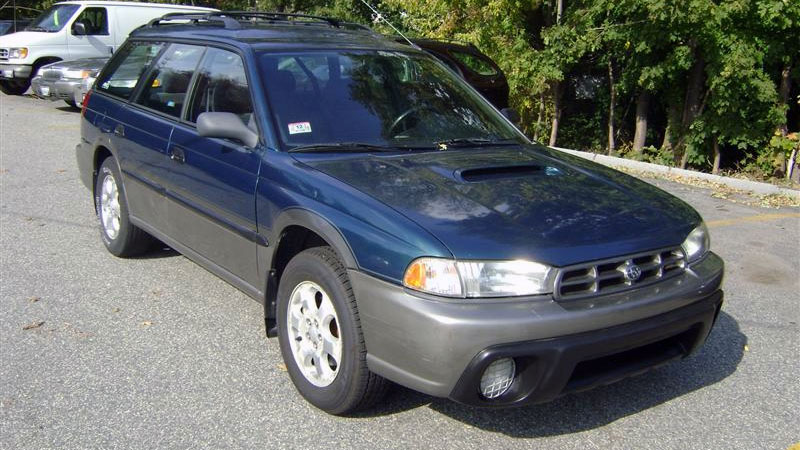
The main problem years are 1996 through 2004. The most common engine to have head gasket failures is the naturally aspirated (non turbo) Subaru 2.5 L four cylinder engine, commonly known as the EJ25 motor.
The single overhead camshaft (SOHC) variant experiences failures much more frequently than the dual overhead camshaft design (DOHC). The SOHC motors can be identified by their single circular indent on each side of the engine. However, DOHC engines produced between 1996 and 1999 have also been known to leak.
The naturally aspirated EJ25 engine was used across Subaru’s lineup and can be found in the non-turbo Baja, Forester, Impreza, Legacy, and Outback.
Head gasket failures are less common on the Subaru 3.0 and 3.6 L H6 models like the Tribeca. They are also rare on the turbo models such as the turbo Baja, Impreza WRX, and Impreza WRX STI.
Symptoms of a Subaru Head Gasket Leak
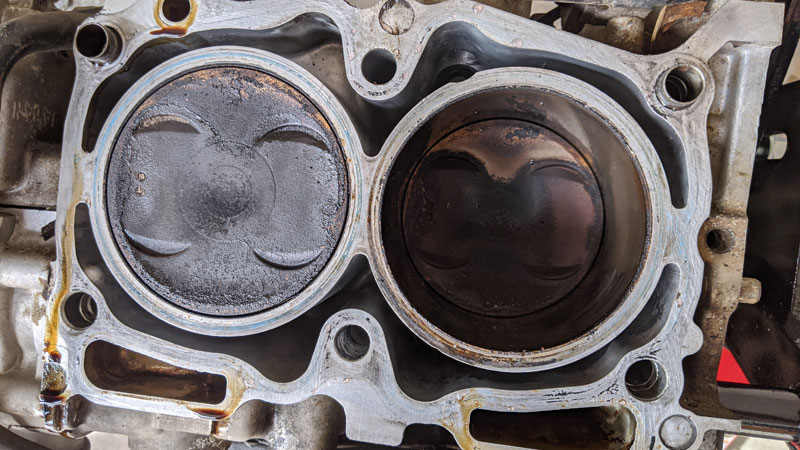
Many symptoms of a head gasket leak on a Subaru are very similar to head gasket leaks on other vehicles.
1) Oil Leak
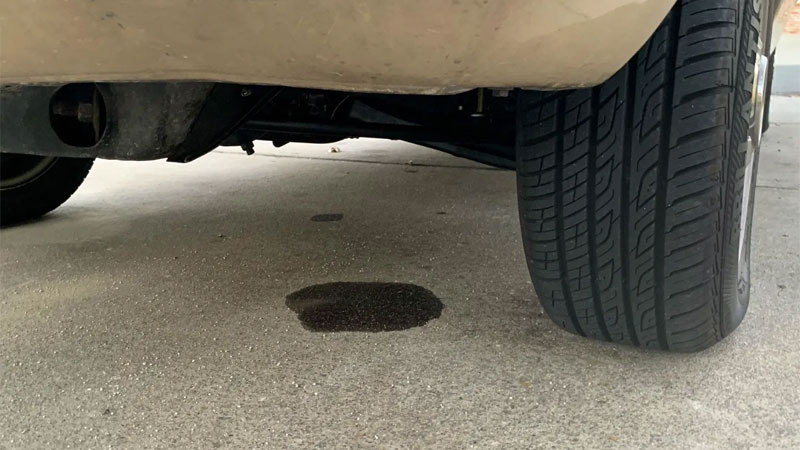
A blown head gasket can manifest in several ways. On first generation Outbacks and second generation Legacy models, the gaskets tend to leak externally. You may notice oil leaks between the head and the block of the engine.
2) Heater Blows Cold

Many Subaru cooling systems route their heater core in such a way that the heater will blow cold air when you have air in the heater core.
Assuming the cooling system was bled correctly, air in the heater core is almost always caused by a head gasket leak. This issue is common on second generation Outbacks, as those leaks tend to be internal.
3) Overheating
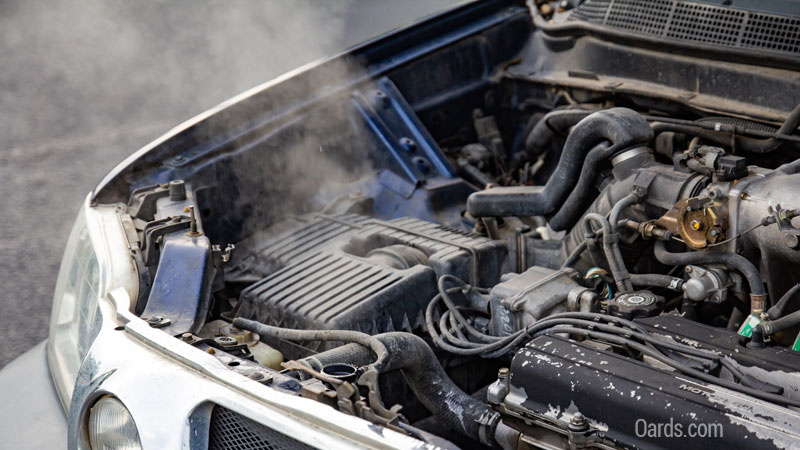
One of the telltale symptoms of a head gasket leak is an overheating engine. If your engine starts to overheat, pull over to let it cool down for a bit before you continue driving.
An overheated engine could cause more engine damage and a more expensive repair bill.
4) White Exhaust Smoke
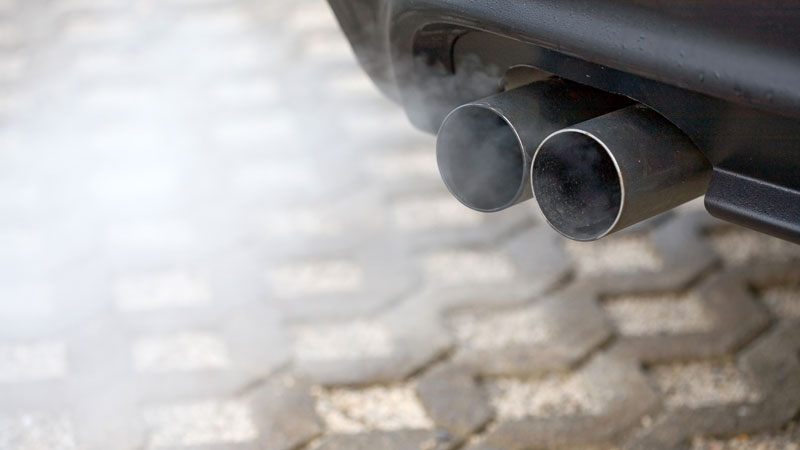
If you notice a thick cloud of white smoke out of the exhaust that persists after initial startup, you probably have a head gasket leak. However, just because you don’t notice excessive white smoke doesn’t mean you’re leak free.
5) Foamy Oil Cap
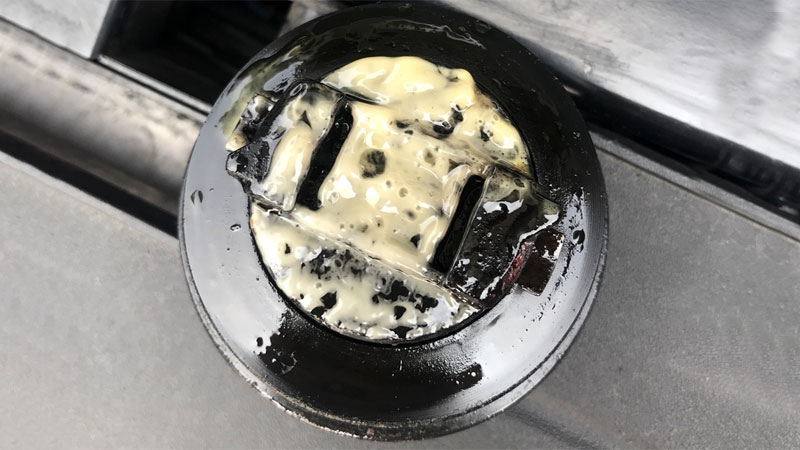
Does the underside of your oil cap look like black coffee or a Starbucks Frappuccino? If it’s the latter, that’s a warning sign that coolant has leaked into the oil system.
Coolant and oil don’t like to mix and often produce a milky foam when they come in contact.
6) Bubbles in Overflow Reservoir
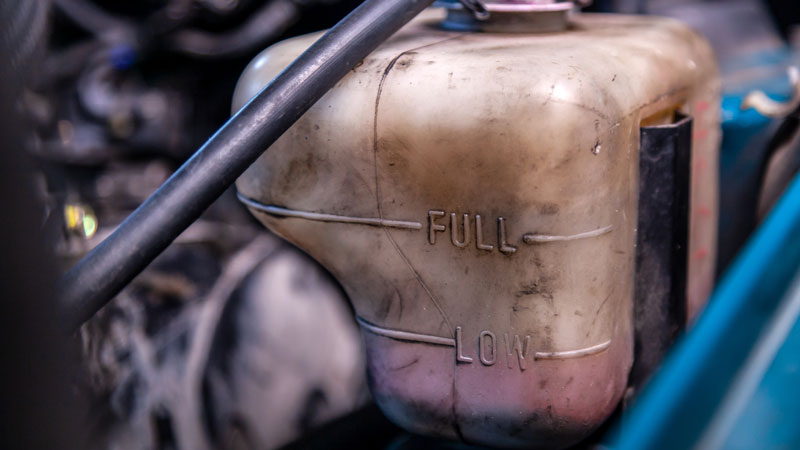
There should be no air in the cooling system. An overflow reservoir that bubbles while the engine is running is a sure sign that something isn’t right.
While you’re in there, check to make sure the radiator cap is good, as a bad cap could behave similarly.
7) Hydrocarbons in Radiator
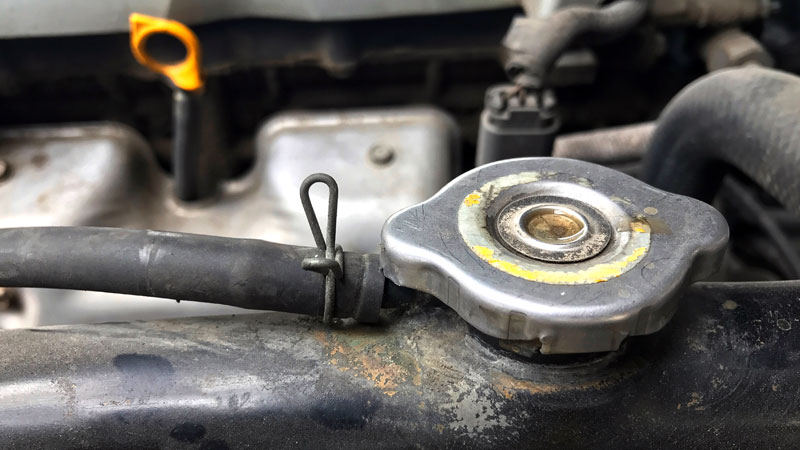
Hydrocarbons are produced when gases ignite in the combustion chamber. If you discover these in the radiator, it could mean your head gasket is leaking combustion gases into the cooling system.
You may notice a burnt oil or fuel smell coming from the radiator or coolant overflow reservoir. If you notice this unusual smell, it may be a good idea to have the cooling system tested as soon as you can.
Head Gasket FAQ
What is a Head Gasket?
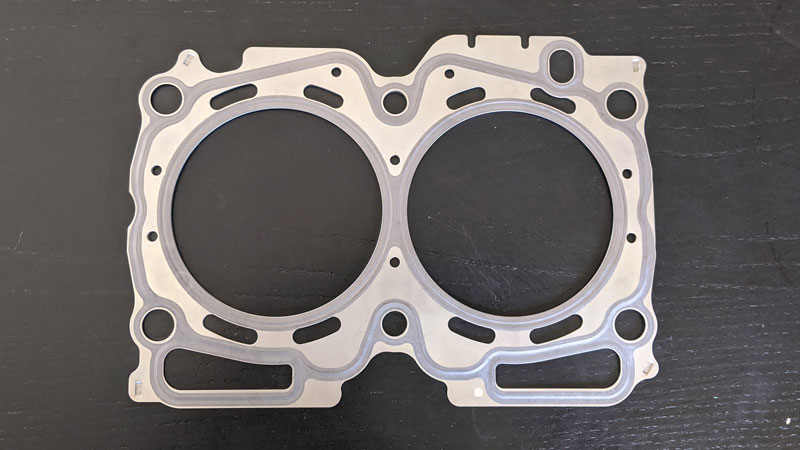
A head gasket provides the sealing surface between the cylinder head and the block. This skinny part has a very difficult job. It needs to keep coolant in the water jackets, oil in the oil passages, and combustion gasses out of the cooling system. It must do this job at a wide variety of temperatures, from cold start to normal operating temperature.
Some head gaskets are a composite made out of other materials such as paper or graphite. Most modern head gaskets are made out of multi-layer steel (MLS).
What Causes a Head Gasket Leak?
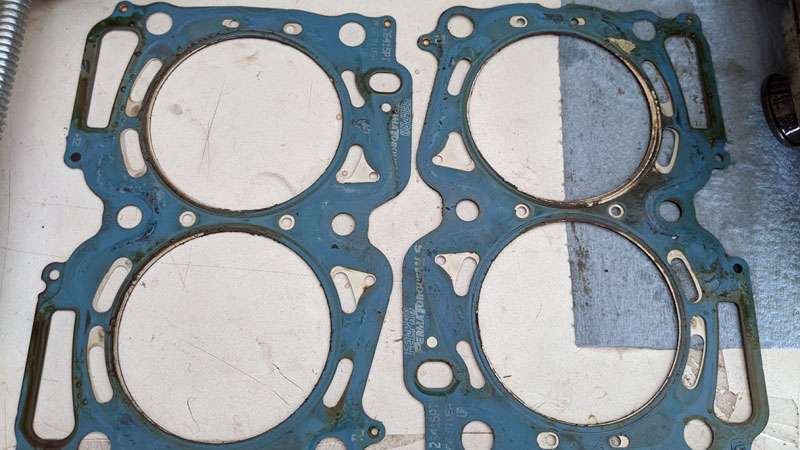
There is a lot of speculation on the exact cause of Subaru’s widespread head gasket leaks.
Some suggested causes have been low quality head gasket material, poor engine maintenance, bad head gasket design, bad water jacket design, detonation, improper head torque procedures, and electrolysis of the coolant due to poor grounding.
The true cause is likely some combination of these reasons.
How Can I Test My Head Gaskets?
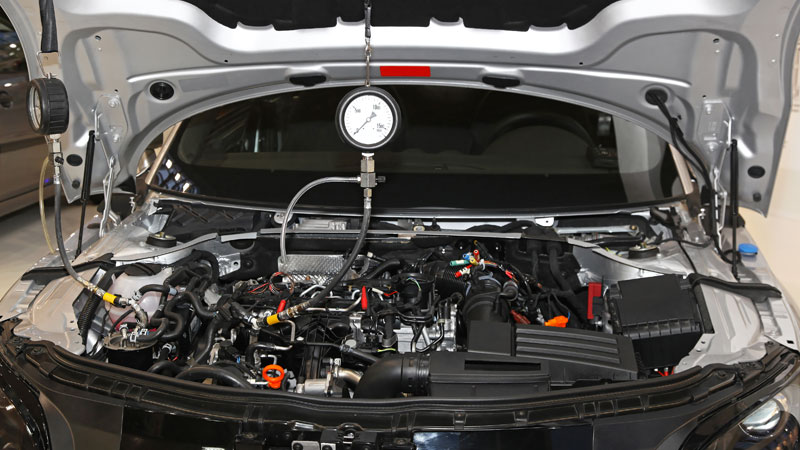
There are several ways you can test the integrity of your cooling system and combustion chamber.
A leak down test is a sure fire way to know if you have a head gasket leak. This test will tell you if any combustion gases are able to escape into the cooling system, or elsewhere in the vehicle while the combustion chamber is supposed to be sealed.
If you see bubbles coming from the radiator filler neck or overflow reservoir while performing a leak down test, you have a head gasket leak.
A radiator pressure test ensures you have no leaks in the cooling system. This test attaches to the radiator filler neck and pumps the amount of pressure your system is designed to hold. If the system won’t hold pressure, you have a leak somewhere.
Radiator hydrocarbon test kits will tell you if hydrocarbon deposits have made their way into the cooling system. Be aware that this test could give you a false positive if the head gasket has ever leaked in the past, even if it has been repaired. You may also get a false positive if you’ve used a petroleum based additive in the radiator.
Do Subarus Still Have Head Gasket Issues?
Over the years the EJ25 engine’s design was revised and gradually phased out. So what year did Subaru fix this problem?
While there is no definitive “safe” year, head gasket leaks tend to be much less common on newer models. If your Subaru is a 2012 or newer, odds are really good that you won’t have any issues.
Can You Drive With a Blown Head Gasket?
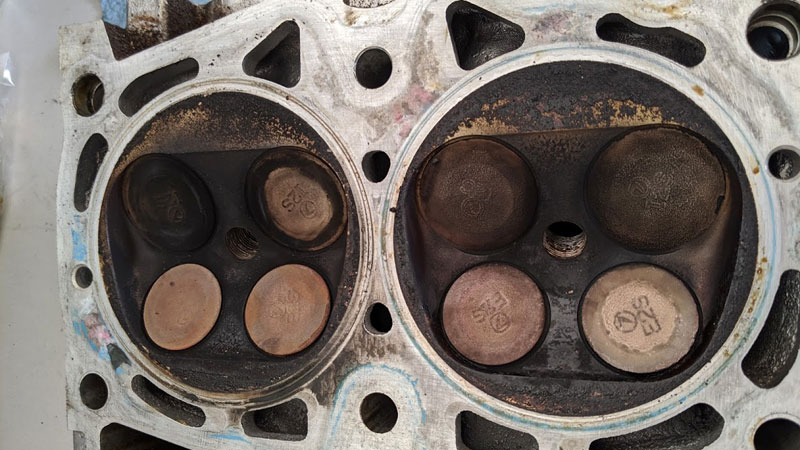
Driving with a blown head gasket is not advisable. The longer the issue persists, the worse it gets. Driving with leaky head gaskets will ultimately cause more engine damage and a higher repair bill in the long run.
In an emergency, leaky head gaskets will probably not prevent you from driving the vehicle, especially if the leak is minor. Watch your coolant temperature gauge closely, as you will likely overheat the engine if you drive for an extended period of time.
Overheating an engine could warp the heads, rendering them unsalvageable. If the heads cannot be resurfaced, replacement heads will not be cheap.
How Much Does a Head Gasket Replacement Cost?
While replacement head gaskets are pretty cheap (around $100), the cost of labor is not. Repair estimates commonly exceed $1,500, depending on the extent of the damage and what other maintenance is performed while the mechanic is in there.
Hold Up… Why Is This So Expensive?

Since boxer engines are so wide, many mechanics remove the engine entirely to perform this repair. Removing the engine makes it much easier to extract the head bolts in particular, which are very long and won’t clear the body with the engine sitting normally inside the engine bay.
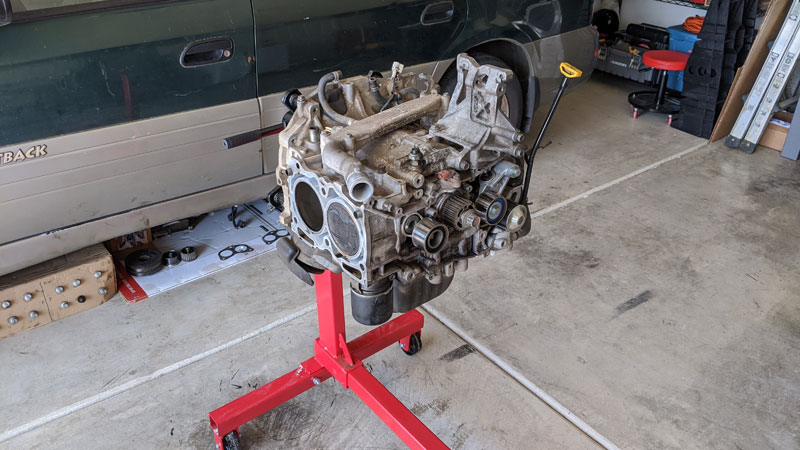
To reach the head gaskets, a mechanic has to tear the engine down to the short block. Both gaskets are typically replaced at the same time. When one head gasket leaks, the other is usually not far behind.
If your car is in the shop for a head gasket repair, consider having them change the timing belt, water pump, idler pulleys, cam seals, both main seals, and the front transmission seal if you’re not sure when they were last replaced.
You’re probably not keen on adding cost to an already expensive repair bill, but these parts are relatively cheap and hard to access normally. There’s no better time to replace them, and you may end up saving money in the long run with this strategy.
Can I Do This Job Myself?
Whether or not you can do this job yourself depends on a number of factors. You will need to be honest with yourself about your own mechanical abilities, then weigh the pros and cons before diving in.
Estimated Downtime
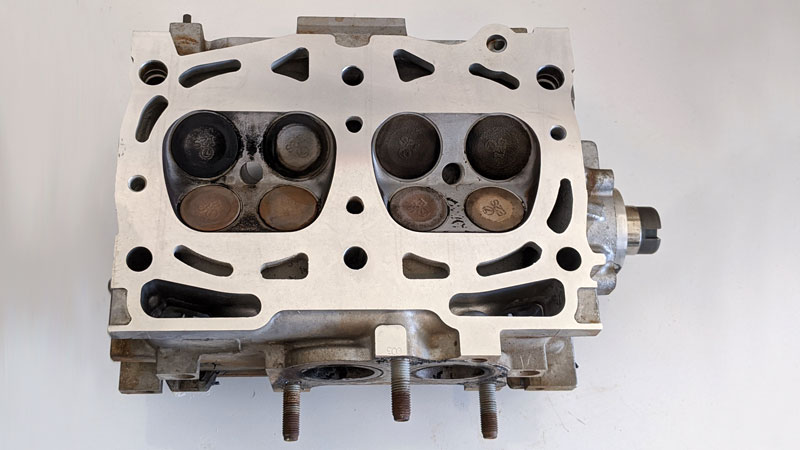
If this is your daily driver and you don’t have a backup vehicle, you probably won’t want to do this job yourself.
A head gasket replacement is very involved. It is not for the faint-hearted, and not something you can tackle over a weekend.
To do the job right, you will need to send the heads off to a machine shop to be resurfaced. The lead time for this step alone could be several days, possibly more if the shop is busy. Consider budgeting extra time and money for a valve job if the valves have seen better days.
Required Tools
You will need some specialty tools you may not have, such as a torque angle gauge and an engine crane (also known as a cherry picker). An impact wrench will make certain tasks much easier, such as removing the crank pulley bolt.
A quality torque wrench is a must. You will also need a socket set, plus several extensions and universal joint sockets to reach the bell housing fasteners. Don’t forget the factory service manual.
Follow the factory service manual very closely. The head tightening sequence is quite unusual and the torque specs are not the same across all models.
You should be able to purchase all of the necessary tools for less than the cost of taking the vehicle to a shop, if you know what you’re doing. As a bonus, it gives you a great excuse to convince your significant other that it’s time to fill your garage with some sweet new tools.
Other Considerations
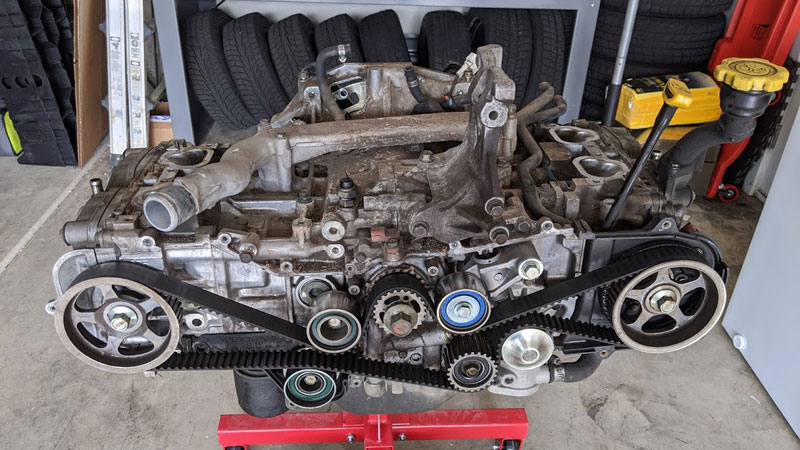
Most Subaru engines are interference engines, which means the pistons are able to contact the valves if the engine is not timed correctly. This would cause enough damage to warrant a full engine replacement in the worst case scenario. If you’ve never replaced a timing belt or this risk makes you uncomfortable, it’s best to leave this job to a professional.
If you’re interested in leveling up your home mechanic skills, picking up a cheap Subaru with a known head gasket leak could give you an excellent learning experience. Before purchasing, make sure you have the patience, funds for tools, and a clean, dry space to work. It’s wise to grab a safety conscious buddy to help you out if you’re new to this type of thing.
Remember, few mechanics will be happy if your car shows up on a flatbed with a bunch of parts strewn about the interior because you got yourself in over your head. Do lots of research, and make sure you can really commit to this job before you dive in on your own.
Have Any Recalls or Service Bulletins Been Issued?
Unfortunately, there haven’t been any major recalls specifically addressing Subaru’s head gasket issue. Nevertheless, it’s essential to stay aware of any recalls affecting your particular Subaru model, as other related problems might indirectly influence the head gasket’s life.
Subaru has issued service bulletins to their dealership network. These bulletins provide important information to help diagnose and resolve the prevalent gasket problem. These informative bulletins help technicians and mechanics in understanding the specifics of the issue, effectively helping them repair your car.
What Can I Do to Prevent Head Gasket Failure In My Subaru?
While there’s no way to make it so you’ll have zero chance of head gasket failure in your Subaru, taking good care of your engine and following the manufacturer’s recommended maintenance schedule will help.
- Regularly check your coolant level and make sure it’s at the correct level.
- Change your engine oil and filter at the recommended intervals. This helps to keep the engine properly lubricated and cool.
- Use high-quality engine coolant and oil that meet Subaru specifications for your specific model.
- Avoid overheating your engine by monitoring the temperature gauge and addressing any issues promptly.
- Inspect the radiator and cooling system for leaks or damage. A malfunctioning cooling system can lead to engine overheating and head gasket failure.
- If you notice any signs of head gasket problems, such as coolant in the oil, white smoke from the exhaust, or rapid loss of coolant, get it checked by a professional mechanic as soon as possible.
Is It Worth Repairing the Head Gaskets On an Older Subaru?
Determining if repairing the head gaskets is worth it on an older Subaru depends on several factors.
- Evaluate the Vehicle’s Overall Condition – If it’s otherwise well-maintained, the repair may be a good investment.
- Consider the Cost – Head gasket replacement can be a labor-intensive and pricey job. Get a few quotes from different mechanics to have an idea of the average cost in your area.
- Assess Age and Mileage – If your vehicle has a high mileage or is approaching the end of its expected lifespan, you might be better off looking into purchasing a newer model.
- Weigh Pros/Cons of Repair vs Buying a New/Used Vehicle – Keep in mind that the newer Subaru models have addressed the head gasket issue, so investing in a more recent model might provide better peace of mind.
- Consider the Emotional Attachment – If you love your older Subaru and are willing to continue investing in its maintenance, then repairing the head gaskets might be a viable option for you.
- Cars with an LS3 Engine (And Why They’re So Popular) - March 26, 2024
- 5 Ways to Tell Your Catalytic Converter Has Been Stolen - March 4, 2024
- How to Break In a New Engine (7 Tips to Prolong Your Vehicle) - February 27, 2024


my 2012 Subaru BRZ doesnt seem to have any issues at 120k miles….do these particular engines have better luck with the head gasket issues? I just replaced the coolant with premium
Yes they have better luck. The FA engine in your BRZ is a completely different design. I wouldn’t worry about it.
I’m a 68y/o woman who spent her life running a rather successful independent BMW shop, which included actually doing the repairs of the vast majority of cars through the stalls. I’ve driven BMWs since 1975 and haven’t worked on any other marque. I retired because a failing body and ticker make it impossible to work on making an omelette much less on a car.
I’m looking at possibly buying from a friend, a 2014 Impreza Sport Limited, 5 door, 2.0 w/ CVT.
I’ve been in the car many times and outside hearing likely ball joints or tierods klunking around out front, which I told her and her wife to get fixed asap. Quite loud, actually.
I’m a pauper.
Tell me in your experience, the likelihood of head gasket issues at the 214,000 mi mark. I understand the caveats in your answer. Advanced pro, remember? 🥰
Thank you very much.
AND, am I correct thinking this us a timing chain drive, NOT a Rubber band? How do I know?
By 2014 you shouldn’t see head gasket issues unless the vehicle was neglected. The 2014 Impreza has the FB engine which uses a timing chain, not a rubber band like the EJ engines had. Head gasket failures primarily affected the naturally aspirated SOHC EJ engines.
You should be good to go if the car is otherwise in great shape!
Of all the problems that can result from vehicle neglect, I’m not aware that head gasket failure is one of them. What kind of ‘neglect’ could cause head gaskets to fail?
Overheating the engine can cause head gaskets to fail. Something as simple as not topping up a coolant leak could cause your vehicle to overheat, as could overloading the cooling system (driving too hard on a hot day, for instance).
If you drive on a hot engine for too long, head gaskets are one of the things that can fail, along with a cracked block, warped heads, etc.
HI- great information! I reread the thread t see if my question may have already been answered but I didn’t see it- sorry is I missed it. I am looking at a 2007 Outback, clearly leaking oil from the head gasket, but temp is fine, no other symptoms. Runs well, no exhaust smoke, 187k miles. What is the likelihood that there is an internal leak as well? Do external leaks usually include internal ones? and again- asking probabilities as I know there are no absolutes, do external leaks usually worsen over time, or remain stable and require mostly the need to be vigilant and add oil ever so often?
Hey John, I didn’t see your question but I answered a similar one here: https://oards.com/subaru-head-gasket-problems/#comment-2042891
Basically, if the car is just leaking oil and isn’t overheating, it’s probably fine. Some leaks are external, some are internal. Check your oil routinely and make sure you aren’t burning any on the hot exhaust components. Hard to say if it will get worse over time. It’s mostly the need to be vigilant about adding oil.
thanks very much for your response- yup got fair amount of oil on the exhaust 🙁
but ya know- driving in the pacific northwest in the winter- how could anything catch fire ?
Even if it’s wet and humid outside the risk is still there. According to Blackstone, the flash point of oil is 380 degrees Fahrenheit. Several other sources across the internet say the exhaust manifold can get close to 1200 degrees in some cases.
The heat shield is less of an issue than the headers themselves, but I would still clean it off and get the oil leak fixed if it were me.
Sean, an excellent article – clear and helpful. Wish I had seen it earlier. Your continued engagement is also very impressive.
I have a 2010 Forester with 150k miles. Last year, a mechanic told me there is a small oil leak in the head gasket. He advised using conventional oil and monitoring the oil level due to the high cost of the repair relative to the value of the car. He said many people do this and keep their car for a long time. I do not have any external dripping. I do smell the oil slightly after turning off the engine.
I have invested in other repairs to keep the car in good shape but wonder how long to keep this car.
Is it ok the keep driving the car if I maintain the oil level? Should I be worried about a sudden failure while driving? Is there a point where the leak makes it risky to drive the car?
Thanks again for all the information you have already provided – it has been a big help!
Hey Rachel, glad to hear you enjoyed the article. It’s generally OK to keep driving the car as-is if you have a small oil leak with no other symptoms. However, if the oil is leaking onto the exhaust manifold, this could be a fire hazard. The engine bay will have a strong burning smell if this is the case. The smell may also enter the cabin while driving. Definitely get it fixed if either of these are true in your case.
If your engine starts to overheat or misfire, that’s when I would definitely encourage getting the head gaskets replaced, assuming blown head gaskets are indeed the root cause.
I would watch the oil level closely though; check the oil every time you get gas. After doing this for a while, you’ll get a feel for how often you need to add oil. Most slow leaks require pretty infrequent top ups. You will find that you eventually have to add a little oil on pretty much every car, even those that don’t leak.
It’s also common for Subarus to leak around the valve covers. Could your mechanic have mistaken an oil leak in this location for head gasket failure?
Thank you very much for this additional information and advice.
Thank you Sean for this. Very useful.
Hi Sean. I hope everything is doing well.
Bad weather and other issues had been slowing down this job and I finally removed both heads, changed the gaskets and a couple of seals, water pump, tensioners and timing belt without removing the engine from its bay. But… engine is stucked. The crankshaft is turning a few degrees. I removed the belt to check where the issue is coming from. Camshafts are rotating 360° without any issues and valves don’t show damages. Crankshaft seems to be stopped by the automatic gearbox. Is there any safety device that would block the shaft? I tried to turn the shaft with the selector on the neutral and connected the battery but it didn’t help. Any suggestions?
You should be able to turn the engine over even if the engine is in the car. Are you turning the engine clockwise? Will the crankshaft rotate freely without the heads on the vehicle?
Hi there.
It had a long time having the car sat in front of my house now. I have spent some time seeking a reason why the crankshaft was « locked ». Last week end I decided to remove the time belt, again, and used the starter. Guess what. The crankshaft turns freely. No damages. I tried to turn manually and again locked. In a different time position, turning only a few degrees. There’s no problems again with the camshafts and valves. I have put everything back but before firing the engine I would love to make these couple of rotations manually, only to check everything will work smoothly before turning the key and feeling the satisfaction of having made the right job. Starter mechanism, automatic gearbox locking device, AWD transmission box ? There are not a lot of options, are they ? Thank you in advance for your help. I have no clue and it is getting frustrating!
Cheers.
What is the year, make, and model of the vehicle? It should usually turn over by hand, but it may be difficult.
How long is your ratchet? Engines are often difficult to turn over by hand just because of the vacuum created when the valves are closed and the inertia of the moving parts. Longer ratchets make this easier. Make sure you are turning the engine the correct direction.
Hi,
My Subaru is a ´95 Legacy station wagon AWD automatic with a 2.0i atmospheric admission, Europe specs. Spark plugs are not in place, so it should not be a compression issue.
I am turning the crankshaft clockwise and it stops when you can hear a « dang » on the back of the engine.
It is so weird.
I will investigate if the starter could be involved.
If the car is in gear the engine won’t turn over. If the torque converter or flex plate were installed incorrectly, that may cause problems. I’m assuming you pulled the engine to replace the head gaskets. The torque converter can be tricky to seat fully. When installed correctly, it should be nearly flush with the transmission bell housing.
If you’re not sure what it should look like, there are a few videos on YouTube that are helpful for installing a torque converter on a Subaru.
Hello.
Thanks for this article. I am the happy owner of a legacy 2.0 AWD wagon ’95 (Europe version). I had this car very cheap with 100k on the clock and it is showing now 120k. No maintenance history, so I have made the basics before driving it almost everyday. I found few weeks ago the coolant level was going down and the temperature gauge is steady and never went upper than the middle of the gauge.
A few days ago I started the engine without any issues, had a stop at ATM and restarted on 3 cylinders with the typical poom poom poom.
Went back home to check engine, checked and changed spark plugs but it did not fix the issue. I’ve found on the floor right under the left head a mix of coolant and oil. There is no foam on the oil cap. I am assuming the head gasket is gone and I don’t link it to the ignition’s failure. Should I expect to have to refurbish the head with new valves? Thanks for this post.
You’ll want to have the heads decked when you replace the head gaskets. This makes the surface flat for better sealing between the head and block. You won’t need new valves or a valve job unless they were already having problems sealing.
I am not familiar with the European Legacy, but make sure you pick up Subaru OEM MLS gaskets if they offer a set that fit your engine. Don’t use Felpro for Subaru head gaskets if you can help it.
Thank you for your reply. My first car when I started my career was a 1st generation Legacy 1.8 4WD sedan with carburetor. The 2nd generation looks very similar to me but with injection. I really enjoyed this car because it was easy to work on the engine without having to remove it from the engine bay. Do you know if it possible to do the gaskets with the engine in place ? Some says it takes less than an hour to remove the engine. Unfortunately I work on my own and I would prefer not to do so. I will take advantage of the repair to refurbish the engine (timing belt, tensioner and water pump) if it still worths it. Parts are extremely cheap for this car here in Europe. Doing it myself it will be inexpensive. If not this car will end in a scrapyard.
It is possible to replace the head gaskets without removing the engine. I’ve never done the job in the car though. Almost everyone says it’s much easier to just pull the engine because you have so much more room. I pulled the engine on my 2000 Legacy Outback to replace the head gaskets, and it was fairly straightforward to do by myself.
If you’ve never pulled an engine before, it’ll probably take you much longer than an hour to pull your first one (especially if you work alone). Budget an entire weekend for the project at the bare minimum. Also, I wouldn’t recommend tackling this yourself without some form of backup transportation. You’ll have to take the heads to the machine shop to get them decked, which will also take more time if their schedule is backed up.
Here’s the beginning of a South Main Auto series doing a head gasket replacement in the car on a similar Subaru: https://www.youtube.com/watch?v=_Xe6pvCk7JM
i just immediately stopped the car but didn’t turn it off, i just waited to see if it got worse, it did creep up just a tad. i drove it home and turned car off. no leaking coolant
i have a 2007 subaru liberty 3.0 h6.
temp gauge started creeping up slowly, 5 mins later goes back down to normal. could this be a thermostat issue?
Are you doing anything differently to bring the temps down, or does it happen on its own?
the temperature gauge actually started to go back to normal.
mite be a coolant temp sensor i can’t be so sure. il get it checked out for the coolant sensor and thermostat as well.
Yeah check the thermostat and coolant level. Might try bleeding air out of the cooling system too.
I had a 1998 Subaru Outback, 5 speed manual, that blew a head gasket while on a road trip with less than 70,000 original miles. This was in 2006 or so, I believe. I had to pay $2000 or so to get it fixed as I replaced the timing belt and everything else as you mentioned besides the head gasket. I was wondering. If I had paid for an extended warranty back then, would have this been covered? I always loved that car, but after that incident at such low mileage, I never went back to Subaru again. I ended up getting a 2005 Honda Pilot, which my daughter still has with over 200K miles on it, and now I drive a 2014 Toyota 4Runner with over 120,000 miles and we’ve never had any engine issues on either. They’ve both been bullet proof so far, with the regular maintenance completed as recommended by the manufacturers.
I don’t know. It depends on the terms of the extended warranty. You really have to read the fine print with those.
My 2005 Outback developed a head gasket leak in under 60K miles. By 100K both head gaskets were leaking, thankfully not into the coolant. Before they started leaking, my wife and I bought a 2009 Legacy that now has 110K and both heads leak oil. Both cars were meticulously maintained. As a result I’ll NEVER buy another Subaru.
For what it’s worth, I’ve had 3 Subarus and all of them treated me well. I bought one Subaru with a blown head gasket and after I replaced the head gaskets, the car ran great until I sold it.
Any aluminum head engine can fail easy. Heat expansion and cooling works on those head gaskets. Aluminum can change shape with heat and pressure. Long time VW nut here. You run um till they POP. Then make a new one. Cost money to have fun. Aluminum engines cost alot of money, unless your grandma on the loud peddle. 100,000 miles is good on this kind of engine. Any way Karl said this from wa state. Later.
Most engines are aluminum these days, and many run well beyond 100,000 miles with only basic maintenance.
I didn’t see any mention of 2011 Outback with 3.6 engines.
My 2011 has 88k mi on it. Am I likely to have a head gasket issue and is it too late for any preventative measures?
While head gasket failures are possible on any engines with head gaskets, the 3.6 is not prone to them. It’s mostly the four cylinder naturally aspirated models for Subarus.
Just change your coolant on the recommended interval (should be found in the owner’s manual) and make sure the coolant stays topped up.
Unfortunately, it would appear the newer Subaru’s are not immune to this. My 2016 Outback with 157K miles was just diagnosed with warped heads, and it is not making it from one oil change to the next without having to dump in a couple quarts of oil. So disappointed, as this is my first Subaru ever, and I’ve heard nothing but good things about them. 🙁
I’ve had two new Subarus (2016+) and they’ve both treated me really well. Did the technician say what might’ve caused the warped heads?
Sorry, just revisited this site to see I missed your comment from March. No, they didn’t say what might have caused it. I’ve taken it to the same dealership its entire life, and they’ve handled all maintenance “by the book”, so I know it’s not due to improper maintenance. Still haven’t pulled the trigger on the repair, as they’re quoting nearly $3K and said I’d be without the car for at least a week, since they send the heads out for machine work. I have a 30+ minute commute to and from work and can’t afford to be without the car for that long, and I can live with just having to put a quart or two in between oil changes.
I have a 2018 Legacy 2.5i with 32,000 miles that is currently in the shop for head gasket and front cam cover replacement. Luckily I bought an extended warranty which covered this or else I’d be in pretty deep water. My whole family owns Subarus all ranging from 2018-2021 and no one else has had any issues as of yet.
It’s odd for a newer Legacy to have that issue. Glad you were able to get it covered under warranty.
Actually it’s not odd at all… I’ve had discussions with specialist aftermarket Subaru mechanics who have been working on nothing but Subarus for 20 years. Any 2.5 EJ motor (including turbo models) is subject to head gasket problems. The issue is not about the gaskets themselves…it’s due to the metal used in the heads that makes them susceptible to warping. Both mechanics said it’s not a matter of ‘if’ but ‘when’ the head gasket goes. This is in addition to the piston ringland failures that are very common if you’re not religious with oil changes (i.e. more frequent than the new longer intervals that dealers recommend just so that they can claim ok servicing costs c.f. other brands) and upper cylinder decarbonising treatment every oil change. It’s pretty shameful that Subaru has persisted with inadequate heads and pistons for so many years, to the detriment of their loyal and long-suffering customers…of which I am foolishly one!
Not all Subarus experience such widespread head gaskets failures like the NA SOHC variants do though. Sure it can happen on a WRX and it does, but it’s much more rare on those than the early 2000s Outbacks, for instance. When a WRX, Forester XT, Legacy GT, or newer Subaru has failed head gaskets, there are often other factors involved such as improper maintenance.
I’ve read that using the wrong coolant can cause head gasket failure on Subarus due to the position of the heads (the bottom of the head gaskets are constantly bathed in coolant since the heads sit sideways). Theoretically, electrolysis makes the coolant more corrosive to the point where it eats through the head gasket material over time. I couldn’t find any definitive proof that this was the root cause, but it was an interesting read. If you know more about this please point me to a link, I’d love to learn more.
actually due to being an all aluminum engine they ALL have head gasket issues. the newer engine “fb25” are oil burners. I had a 1998 forester that was a good car for almost 300 k, but my 2015 needed a new engine at 100,000 miles with numerous other problems with the fancy vehicle dynamics system, wheel bearings, fragile front control arms and the list goes on, Subaru makes a nice car but they can be expensive to drive now that they loaded up the “new tech features”
They don’t all have head gasket issues. This particular issue is limited to the older naturally aspirated SOHC engines.
Any year, make, and model can blow a head gasket (except rotary engines, since they don’t have cylinder heads; their equivalent is a blown coolant seal). It also may depend on how the vehicle was cared for.
426k on my 2002 Legacy. Leaked oil at 260k. Minimal. Just started to leak coolant from head gasket. Going with a new short block and rebuild heads. All new timing belt components,hoses, and radiator. Car like new.
I just had the head gasket repair on my 2013 Subaru Outback at 100,000 miles, also had this same problem in a 2007 Subaru Outback. This is unacceptable, I won’t be buying anymore Subarus.
Subaru recommends adding Subaru Cooling System Conditioner when replacing the coolant in order to prevent head gasket and other cooling system leaks. Very few Subaru owners are aware of this and most shops don’t add it when doing a coolant change. My 2010 Forester (2.5L, EJ253) has over 250k miles and has never had a head gasket leak, either external or internal (verified with periodic engine oil analysis). However, whenever I replace the coolant I always add the Subaru-recommended Cooling System Conditioner and there has not been any consequences, such as clogged heater core, from using it.
My ’99 subaru legacy sus limited edition started the problem at 85,000 miles approx, I had the motor pulled and head gaskets replaced by local mechanic. It lasted ok for about 1,000 miles then put coolant into bottle and pressed cap off with engine staying cool to touch. I had it redone once more with heads to shop for checking, new head bolts and complete gasket kit, new oil and coolant. I have new radiator, new water pump, new everything on this car and the white smoke rolls out of the exhaust but not into the oil. Camera view shows it did have a leak above 2cylinders prior to last head gasket job done. What can be done now as this car is like new yet?
Do you know which gaskets were used during the head gasket replacement? Most people have great success with OEM multi-layer steel (MLS) gaskets.
Great article! I’m think about buying a 2010 Subaru Outback should I be concerned about the head gasket failing?
Thanks Allie, glad you liked it.
Head gasket failure is a possibility, as the 2010 Outback had the EJ253 in North America (I think you’re in the clear if you live in Europe). This was another SOHC engine like the EJ251 and EJ252 that was prone to bad head gaskets.
Ask if the head gaskets have ever been replaced before you buy. If not, you may want to consider buying a 2013 or newer. Those have a lower likelihood of encountering this issue. If you’re set on the 2010 model year, you could always do a compression and leak down test on the vehicle before buying if you’re concerned.
Would you say that upgrading to a high flow exhaust, cold air intake, and tuning it would increase the chances of a head gasket issue (2018 WRX)? I saw some white smoke the other day and it’s freaking me out. Was about 5 minutes after cold start.
Unlikely. Head gasket issues don’t plague the FA20 (in the 2018 WRX) like they did the SOHC EJ25.
How much white smoke did you see? Was it more visible when you hit the gas?
Thanks for the great rundown on the head gasket issue. I just looked at a 2009 Legacy 3.0 6cyl. and am leaning towards buying it, as it seems to be in great shape at 100,000 miles, and well-maintained. I didn’t ask about the head gasket as it occurred to me on the way home. I’m going to have a mechanic look it over tomorrow, and suggestions/tips on what I should consider before buying? Thanks so much-
Glad you liked the article, Jonathan. You can ask about the head gaskets, but they probably won’t be an issue on that 3.0 engine.
If you’re having a mechanic look it over before buying, you’re already ahead of the vast majority of people! Assuming the vehicle is mechanically sound, think about what your use case is (that is, what you would do with your car) and make sure that Legacy fits your description.
In case you’re new to Subarus: you should rotate the tires with every oil change and if one tire goes bad, you should replace all four at the same time. All tires have to be within 2/32 of an inch in tread depth of each other, and all tires must be the same diameter. This protects the AWD system and more information can be found in the owner’s manual.
From the extensive reading I did when the head gasket went on my 2001 Forester I was convinced that preventative maintenance would have been the way to avoid these failures. Specifically, replacing the coolant at a short interval (20k miles) would eliminate the gradual chemical action of the poor grounding reacting with the coolant and changing it to have a more corrosive composition that worked against the head gasket at the point nearest the ground. (forgive me if I am a bit off on this description, it’s been a several years). I am looking for a Subaru for my daughter now and haven’t seen this theory gain traction in the reading I am doing now. Has it been disproved? I would like to prevent the issue or reduce the risk factors if I can.
Preventative maintenance may help, but I’m not sure if it would completely solve the problem. It seems to be a design flaw of the original head gaskets. The poor grounding theory certainly has my interest, and if it’s true then replacing the coolant frequently should mitigate the issue. Last I read, this is just a theory and hasn’t been proven.
Typically when you replace the factory gasket with an OEM multi-layer steel (MLS) gasket, you won’t experience head gasket issues on that car again. This assumes of course that the block and head surfaces are clean (with the correct roughness and flatness) and have been torqued to Subaru spec.
What year and model Subarus are you looking at? If you’re worried, you can avoid the 2.5L single overhead cam engine and you should be fine. I personally wouldn’t have a problem buying a car that had the head gaskets replaced properly though.
My 2019 3.6 Outback Limited with only 17,000 miles is in the dealership now for head gasket replacement. Probably the last Subaru I will own as they haven’t fixed this long standing problem
That’s strange, those models aren’t typically afflicted with head gasket issues. I take it the vehicle wasn’t under warranty?
I am a 70 years young lady, I have a 2006 Subaru outback, in 2018 I had a Subaru dealer change my head asked. Now 3 1/2 years later I have an oil leak. Any comments will help, I feel as though Subaru did me wrong.
3.5 years is a long time. Where is the oil leak coming from? They are probably unrelated issues if the oil leak isn’t coming from the head gasket.
I have a 2003 Outback 3.0 h6. 59,000 miles. Does this size engine have the same issues with head gasket as the smaller ones? I’m 74, inherited this well-maintained, lovely car but wonder how safe it is for annual 1500 mile drives. I have none of these symptoms but think I have a very small amount of something showing up on the driveway.
I haven’t heard of anything out of the ordinary on those. I think it’s mainly the four cylinder EJ engines (I believe yours is an EZ).
59K miles?! Let me know when you want to sell it 😉
Hello Sean,
Your article is very informative and easy to understand. I’m a young 70-year-old lady and certainly don’t need this kind of problem. I was going to buy a Subaru Forester 2018 or 2019, now I’m very hesitant. Since it’s going to be the last car I buy, I could go for a new 2021. Spending that kind of money for a new car and worrying about the mechanical problems that could arise does not make sense to me. Help! Should I take a chance? Thanking you in advance for your reply.
Thanks for the feedback, Nicole! Buying a new car with a warranty is usually pretty safe. I have owned a new Subaru myself and didn’t have a single problem with it. If you’re looking for a 2018 or 2019, see if you can find a certified pre-owned (CPO) example.
If you like Subarus, I wouldn’t let an issue on a previous generation hold you back from buying a new vehicle. All makes have had mechanical problems at one point or another… even Toyota.
If you do happen to encounter a defect or mechanical problem under warranty, you can simply bring the vehicle into the dealership and they should address the issue at no charge to you. Wear items like brakes, clutches, and tires are usually not covered.
Hello Sean!
Thanks for a great article…very detailed and super informative!
I have a 2012 Subaru Legacy 2.5i Premium 6-spd with ~76,000 miles that I plan to keep for the foreseeable future. I’m going to have the timing belt, related components, and water pump replaced based on the 105 months or 105,000 miles maintenance schedule. Per the article, 2012’s and newer should not have any issues, but a leak down test is the best way to diagnose a head gasket issue.
Since it shouldn’t have this issue at all and because the miles are low and the head gasket issue doesn’t usually come up until 100,000 – 150,000 miles, do you think it would be a waste of money to have a leak down test done now?
Should I wait to have the leak down test done when the spark plugs are replaced next, which will be roughly end of 2023?
How much should a leak down test cost?
Hey Ariel, thanks for the feedback. Leak down tests can be done at any time, so it’s really up to you if and when you want to do it. If you’re not experiencing any problems, there’s probably no need to perform the test at this time. The tests tend to cost around $200, give or take $50. To some people, the peace of mind may be worth it.
Ariel, a 2012 would not have timing belts; it has timing chains, so unless your chain tensioners fail, they should last the life of the engine with no replacement
2014 2.5 44,000 miles blown head gaskets
Dang, that’s not very many miles. Do you know what caused it?
Subaru’s inability to make an antiquated boxer engine design durable, most likely 😉
Haha. I will say they seem to have gotten better over the years.